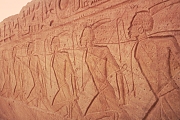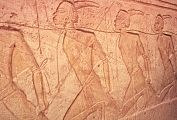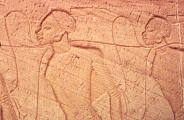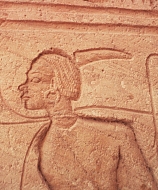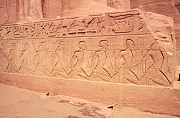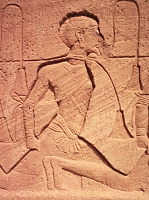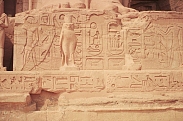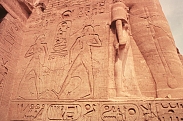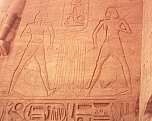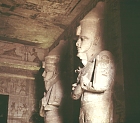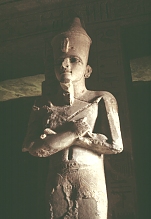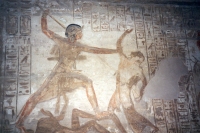The Great Temple of Ramses II
Dynasty XIX, c. 1275-1225 BCE
The Great Temple of Ramses II (left) and the Temple of Hathor/Nefertari (right)
These rock-cut temples are located in the ancient Wawat (or the legendary Ybsambul) in Nubia, near the borders of Sudan, about 300 kilometers from Aswan. Earlier temples in Nubia had been located within forts, but here the confidence of Ramses II, whose reign may have lasted as many as 67 years, is illustrated; these temples, probably once brightly colored, were cut into the natural rock and lapped by the Nile. After eleven centuries of oblivion, these temples were rediscovered in 1813 when Johann Ludwig Burckhardt saw by accident the upper parts of the colossal figures. In 1817 Giovanni Battista Belzoni found the entrance, partially freed from the sand. In the following years these temples were often partially covered by shifting sands. |
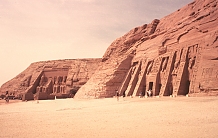 |
Today visitors see the reconstructed temples now relocated on higher ground (60 meters directly above their earlier position) after the heroic international rescue efforts to save these treasures from Lake Nasser. |
|
|
| The facade of the Great Temple of Ramses is about 38 meters long and 31 meters high. The temple is dedicated to the most important gods of the New Kingdom, Ptah (the creator god of Memphis), Amun-Re (the great god of Thebes) and Re-Harakhte (sun god of Heliopolis), as well as to the Pharaoh Ramses II himself. The four colossi, statues of Ramses II (c. 1290-1224 BCE), are more than 20 meters high and about 4 meters from ear to ear. |
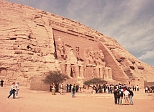 |
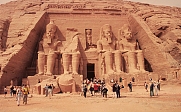 |
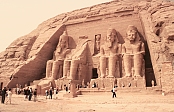 |
|
|
| The colossi depict Ramses II seated with his hands on his thighs. The statue second from the left is broken, with part of its head and trunk on the ground below. Graffiti by 19th century visitors are on the legs of the statues (center) and repeated cartouches give Ramses’ name (right). |
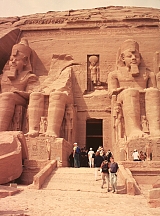 |
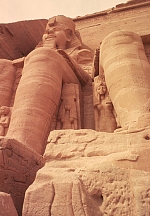 |
 |
|
|
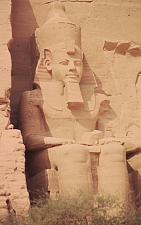 |
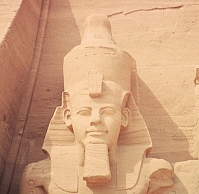 |
The young, handsome face is finely carved. He wears a double crown on his head and a heavy nemes flares out on both sides of his face. The line of the smiling lips is more than a meter long. |
|
|
 |
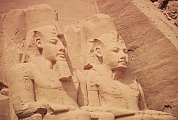 |
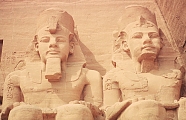 |
|
|
| The doorway to the interior is 7 meters high. A statue of Re-Harakhte with the falcon head is in a niche over the entrance. The god is flanked by low relief depictions of Ramses II who presents him with a tiny statuette of Maat–goddess of Truth and Justice. The cornice above the entrance has a frieze design of uraei (the sacred asp) and above the cornice there are twenty-two high relief statues of seated baboons with their hands raised in worshipping the sun. |
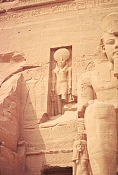 |
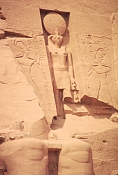 |
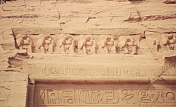 |
|
|
| Smaller sculptures between the legs and at the base of the colossi represent members of the royal family: “Princess Nebt-taui, Princess Bant-anat and an unidentified princess on the southernmost colossus; Queen Tu’e, the King’s mother, Queen Nefertari, his wife, and his son prince Amen-hir-khopshef to the left of the doorway; and beside the statues to the right (north), Queen Nefertari, twice represented, and Prince Ramses” (Kamil 124).
Have a question Contact Us:
[contact-form-7 id=”80″ title=”Contact form 1″] |
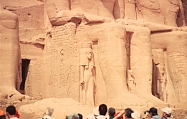 |
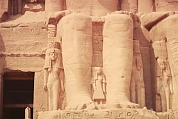 |
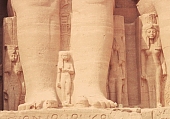 |
